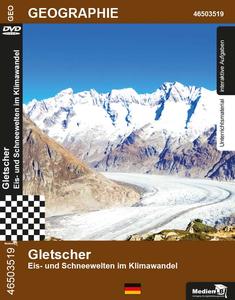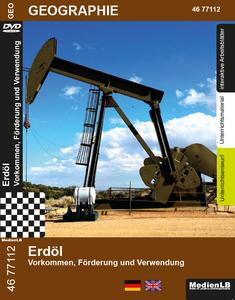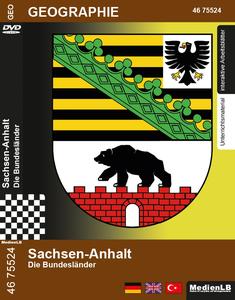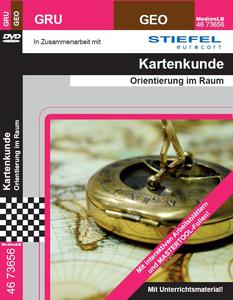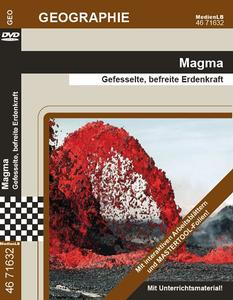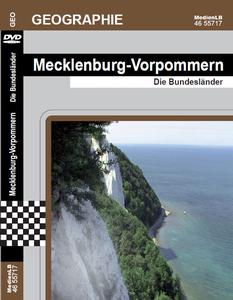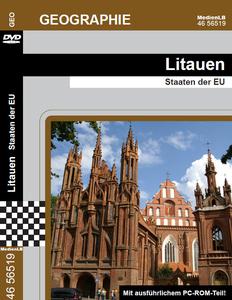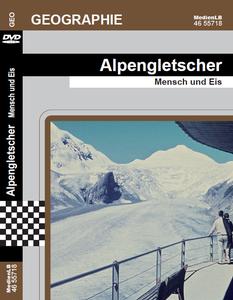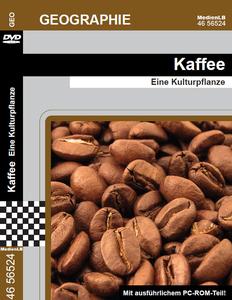-
Handelsrouten
Der Weg durch den Panamakanal
Der 1914 eröffnete Panamakanal verbindet Atlantik und Pazifik für den Schiffsverkehr und erspart die Umschiffung Südamerikas.
More about the DVD -
Geologic Activities
Volcanoes, Geysers, Continental Plates
The formation of our earth began according to today's knowledge from a huge cloud of dust and gases about 4.6 billion years ago.
More about the DVD -
Changing climate
What can be done about it?
It was triggered by industrialisation. It is changing the climate all over the world. Young people have come together and protested against it. The talk is of climate change.
More about the DVD -
Tea
History, Cultivation, Culture
It is a popular hot drink all over the world. The Dutch brought it from China to Europe. It is the centre of ceremonies and traditions in various countries.
More about the DVD -
Desert
Types, Vegetation, Fauna
Deserts and semi-deserts cover roughly a third of the entire landmass of the Earth. A huge area of our planet is thus defined as an arid region.
More about the DVD -
Climate Phenomena
Impact of El Nino on the Weather
Weather, atmospheric condition and climate must be clearly distinguished. Weather describes the current state of the atmosphere surrounding us in a certain place.
More about the DVD -
Freight Traffic
How do Trade Flows Work?
Most of us have probably ordered goods on the Internet at some point since online trade is perpetually booming.
More about the DVD -
Lignite
Formation, Deposits and Mining
Lignite, or brown coal, is an important energy carrier for providing Germany with electric power.
More about the DVD -
Hesse
The Federal States of Germany
The federal state of Hesse is located in the centre of Germany and borders on the federal states of Lower Saxony, Thuringia, Bavaria, Baden-Wuerttemberg, Rhineland-Palatinate and North Rhine-Westphalia.
More about the DVD -
Brandenburg
The Federal States of Germany
The federal state of Brandenburg is located in eastern Germany and encloses the federal capital Berlin in its centre.
More about the DVD -
Coasts
Shapes and Formation
The border area of the ecosystems of land and sea, which influence each other, is referred to as coast.
More about the DVD -
The River as a Lifeline
Nile, Amazon, Mississippi
From source to mouth our rivers are constantly on the move. They count among the most dynamic biospheres on Earth and are vital connections for numerous plants and animals between otherwise separate habitats.
More about the DVD -
Rome
Capital of Italy
On the Tiber, in the centre of Italy, there lies the Italian capital of Rome.
More about the DVD -
Natural Gas
Reserves, Extraction, Use
It provides heat for radiators and for cooking, generates electricity and even drives cars: natural gas is an important energy resource – worldwide, and also here in Germany.
More about the DVD -
Lake Constance
Living by the Water
Lake Constance is not only beautifully situated at the foot of the Alps, surrounded by a fertile countryside – you can also tell many stories about it, and thus learn something about its history and the people who live there.
More about the DVD -
Petroleum
Deposits, Extraction, Use
Petroleum – a resource without which our modern industrial society is hardly conceivable. It serves as a basis for the fuel of almost all means of transport, but also for generating heat and electricity.
More about the DVD -
Urbanisation
The Emergence of Metropolises
Cities, that is, concentrations of culture areas, existed already in ancient times, but the spread of metropolises worldwide, the so-called metropolisation.
More about the DVD -
Berlin
The Federal States of Germany
Berlin is located in Eastern Germany, surrounded by the federal state of Brandenburg. The city can look back on an eventful history: as capital of Prussia, of the Empire, of the Weimar Republic and during the period of National Socialism. Due to the partition of Germany after the Second World War, the eastern part of Berlin became the capital of the GDR while West Berlin had the political status of an island right in the centre of the GDR until the German reunification. Today Berlin is a federal state, the largest city in Germany and capital of the Federal Republic of Germany, and the undisputed centre of its region, the federal state of Brandenburg, which surrounds the city.
More about the DVD -
Hamburg
The Federal States of Germany
Hamburg is the second largest city in Germany and is located in the North German Plain at the lower course of the Elbe. As a federal city state, the Free and Hanseatic City of Hamburg is both a municipality and a state of the Federal Republic of Germany. The greater Hamburg area is the economic centre of North Germany. The port, its gateway to the world, is the centre of the dynamic economic metropolis.
More about the DVD -
Bremen
Federal States
The federal state of Bremen is located in the northwest of Germany and entirely surrounded by the federal state of Lower Saxony. As one of the three city states the federal state of Bremen is not only the smallest German federal state but comprises two cities, the city of Bremen and the city of Bremerhaven. Thus Bremen is a two-city state which is unique in this form in the Federal Republic. The probably best-known landmarks of the Hanseatic city are the Town Musicians of Bremen – after the world famous fairy tale of the Brothers Grimm – and the Bremen Roland, declared a world heritage site by UNESCO. The relatively young port city of Bremerhaven owes its rise to become a world-famous overseas port above all to the about 8 million emigrants who left Europe via Bremen from 1832 to 1974.
More about the DVD -
The Green Paradox
Why the Earth Gets Warmer
Carbon dioxide is a nontoxic gas. It is formed in our bodies and in nature in the combustion of carbons. These are contained in all organic materials.
More about the DVD -
Paris - the Megacity
Savoir Vivre
Paris is the capital of France and located in the heart of Europe. France is virtually the only Western European country where life is so strongly oriented towards the capital.
More about the DVD -
Saxony-Anhalt
The Federal States of Germany
The federal state of Saxony-Anhalt is not only abundant with natural beauty but also boasts a diverse landscape of castles, palaces and churches, some of which are UNESCO World Heritage Sites.
More about the DVD -
Our Solar System
Planets
Looking up at the cloudless night sky is something special. It is a spectacle that we are offered free of charge every clear night.
More about the DVD -
Northrine-Westphalia
The Federal States of Germany
North Rhine-Westphalia unites many contrasting mentalities and forms of life and landscape. It is a land of low mountain ranges, lowlands and vibrant metropolises.
More about the DVD -
Globalisation
Change through Trade
A visit to the weekly market. Here they lie peacefully side by side: pears and apples from local regions next to exotic fruits such as kiwi, lychee, papaya and mango.
More about the DVD -
High-tech Locations
Innovation Secures the Future
The satellite dishes of the first terrestrial communications site on German ground in Raisting near the Ammersee have been a symbol of high-tech in Bavaria for decades. The very first satellite dish was still protected from all weathers by an air hall. Today it is an industrial monument.
More about the DVD -
Thuringia
The Federal States of Germany
"My name is Bodo Ramelow. I am Prime Minister of the Free State of Thuringia. It is a beautiful country. Its abundance of nature and environmental beauty, its wealth of art and culture, wonderful cities and history are truly exciting. We have so much to offer and I’m always glad about Thuringia’s wide diversity."
More about the DVD -
Doctrine of Maps
Spatial Orientation
..... But how does a compass work? The answer is: by magnetic force. When you place a magnet amidst metal filings, you can see how these filings are pulled to the magnet. And when you take a closer look, you can see that the filings arrange themselves in specific directions at the magnet. This way, you can see where the field lines of the magnet run. The horseshoe magnet has a north pole and a south pole like the Earth. The direction of the cuttings tells you where the field lines along these poles are.
More about the DVD -
Earthquakes
Origin and Consequences
For millennia, people have been afraid of earthquakes. A force of nature that regularly devastates whole regions and claims thousands of lives
More about the DVD -
Lower Saxony
The Federal States of Germany
Between the North Sea and the Harz, Ems and Elbe, stretches one of Germany’s federal states in which, according to legend, once the Pied Piper of Hamelin, Till Eulenspiegel and the lying Baron Munchhausen did their mischief.
More about the DVD -
Israel
Between Tradition, High-tech and Conflicts
The territory of present-day Israel is one of the oldest cultural regions on Earth. It is the Holy Land of three world religions: Judaism, Christianity and Islam.
More about the DVD -
Magma
Chained and Releqsed Power of the Earth
The face of our home planet is subjected to constant change. Mountains are created and eroded over time, oceans flood continental areas, glaciers assume gigantic proportions, modify landscapes and melt – all this happens mostly in very long geological periods of time.
More about the DVD -
Floods
From Natural Phenomenon to Disaster
Most of our earth is covered in water. Without water, no life. The water on our earth is in a constantly renewed global cycle.
More about the DVD -
Cultural Change in Mexico
The Zapatista Movement
31 federal states and the capital district of Mexico City form the United Mexican States. With an overall area of almost two million square kilometres, Mexico is the fifth-largest country on the two American continents. Globally, Mexico ranks eleventh with a population of roughly 110 million people.
More about the DVD -
Amazon Basin
Rainforest and Biodiversity
Because of its overwhelming biodiversity, the Amazon Basin is rightly referred to as the crown jewel of nature on earth.
More about the DVD -
United Arab Emirates
Alternatives to Oil
Abu Dhabi is the capital of the United Arab Emirates. They consist of seven emirates. The United Arab Emirates are a country where the contrasts could hardly be greater: wealth from crude oil, wastage of crude oil and at the same time orientation towards a future in the post-oil era.
More about the DVD -
The Rhine – a Natural Area
From its Source to its Estuary
At 1,230 km the Rhine is the second longest river in Western Europe. From its source in the canton of Graubünden in the Swiss Alps, it travels through Austria, Germany and empties into the North Sea in the Netherlands.
More about the DVD -
Rhineland-Palatinate
The Federal States of Germany
The German Federal State of Rhineland-Palatinate lies in the southwest of the Federal Republic of Germany. This DVD begins with an overview over the state with its nine natural regions: Ahr Valley, Eifel, Westerwald, Mosel-Saar, Huns- rück, the Nahe region, Palatinate with the Palatinate Forest, Middle Rhine-Lahn-Taunus and Rhenish Hesse.
More about the DVD -
Mecklenburg - Western Pomerania
Federal States
Mecklenburg-Western Pomerania is the most north-eastern land of Germany. It encompasses an area of 23.174 square kilometres.
More about the DVD -
Saxony
The Federal States of Germany
The federal state of Saxony lies in the southeast of the Federal Republic of Germany. Besides an overview of the state, this DVD offers a detailed description of the character and history of Saxony’s natural landscapes.
More about the DVD -
Saarland
Federal States of Germany
One of the small States of the Federal Republic of Germany is also represented in this film series. A turbulent history in a border situation between two power blocs, coal and steel, structural change, services and nanotechnology. Join us on a short trip through Saarland!
More about the DVD -
Bavaria
The Federal States of Germany
The free state of Bavaria is one of the most diverse states of the Federal Republic of Germany. Amidst the Alps with the Alpine Foothills and the Frankenwald and Lake Constance in the southwest, there are various regions that considerably differ from each other with regard to landscape as well as to economic basis.
More about the DVD -
Capitals of Northern Europe
Helsinki, Copenhagen, Oslo, Reykjavik, Stockholm
This DVD presents the five capitals of Northern Europe: Helsinki, Copenhagen, Oslo, Reykjavik and Stockholm. The pupils learn about the topographic situation of the capitals in Europe and in their respective country. The history of the cities and their development are outlined, as well as their particularities.
More about the DVD -
Capitals of Central Europe II
Bratislava, Budapest, Prague
This DVD presents the capitals of eastern Central Europe, Bratislava, Budapest, Prague and Warsaw. By way of intro- duction, the pupils learn about the natural and climatic bound- aries of the Central European region and which countries it encompasses.
More about the DVD -
Capitals of Central Europe I
Berlin, Bern, Vaduz, Vienna
This DVD presents the German-speaking capitals of Central Europe, Berlin, Bern, Vaduz and Vienna. By way of introduction, the pupils learn about the natural and climatic boundaries of the Central European region and which countries it encompasses.
More about the DVD -
London
European Capitals
This DVD offers a clearly structured overview of the bustling city on the Thames. The students are to realise that the geographical situation of London in the centre of the island state is decisive both for its climate and its special historical and political significance within Europe.
More about the DVD -
Venice
Queen of the Seas in 1968 and 2008
Showered with superlatives, Venice is doubtlessly an out- standing city, welcoming up to 15 million tourists annually. But despite the powerful magic it radiates, the city is confronted with seemingly overwhelming problems. Hence, detractors keep talking about a dying city.
More about the DVD -
New York City
1967 and 2007
A global metropolis of superlatives: the world capital of trade and culture is bustling with 8.1 million people from all nations. Due to its sea port, New York City became increasingly significant in the 19th century, before proceeding to transform into a unique megacity.
More about the DVD -
Czechia
EU Member States
This DVD offers a clearly structured overview covering the following aspects: Situation in Europe, size and population, landscapes (Bohe- mia, Moravia), mountains (Sudetes, Sudeten Mountains, Ore Mountains, Bohemian Forest), rivers (Elbe, Vitava), the climate, history (short overview, traffic, transport and infra- structure, economic structure (agriculture, industry, mining and energy supply), tourism, car industry (Skoda), breweries (Budweis, Pilsen), spas, important cities and sights, capital of Prague, traditions, language, education, food and drink, culture and music.
More about the DVD -
Slovenia
EU Member States
This DVD offers a clearly structured overview covering the following aspects: Situation in Europe, size and population, regions (Alps, Dinar Mountains, Pannonian Plain, Mediterranean coast), mountains (Julian Alps, Dinar Mountains, Karawanken), landscapes of particular interest (karst mountains, caves, Grottos of Adelsberg, “poljes”, Lake of Cerknica), rivers (Drava, Mur), the climate, history (overview up to today’s form of government, Yugoslavia, Declaration of Independence in 1991)...
More about the DVD -
Hungary
EU Member States
This DVD offers a clearly structured overview covering the following aspects: Situation in Europe, size and population, landscapes (Little and Great Hungarian Plains, Puszta), watercourses (Rába, Danube, Lake Neusiedl, Lake Balaton), mountains (Bakony Forest, Mecsek, Matra, Bükk), the climate, history (overview up to today’s system of government, national rebellion of 1956, change of system in 1987)...
More about the DVD -
Slovakia
EU Member States
This DVD conveys to the pupils a comprehensive picture of the European neighbour state of Slovakia. Topographical in- formation on Slovakia is followed by an overview of its typical natural landscapes, for instance, the alpine mountain ranges of the Carpathians, the Slovakian Ore Mountains with their rich ore deposits, the Slovak lowlands of the Little and Great Hungarian Plains, the Danube Valley and the Váh Valley and its many lakes and reservoirs.
More about the DVD -
Poland
EU Member States
This DVD conveys to the pupils a comprehensive picture of the European neighbour state of Poland. Topographical information on Poland is followed by an overview of its typical natural landscapes, for instance the Baltic seashore from the Pomeranian Bay to the Gulf of Gdansk, the adjacent hills of the “Baltic Ridge” und the lowlands of Silesia and Mazovia.
More about the DVD -
Lithuania
EU Member States
This DVD conveys to the pupils a comprehensive picture of the Baltic state of Lithuania. Topographical information on Lithuania is followed by an overview of its four regions, which are distinguished by their respective traditions, dialect and landscapes: Upper Lithuania, Lower Lithuania with the Memel Territory, the region of Sudovia and the region of Dzukija.
More about the DVD -
Latvia
EU Member States
This DVD offers a clearly structured overview of Latvia focusing on the following aspects: Situation within the EU, size and inhabitants, landscapes (regional landscapes, mountains, rivers), fauna and flora (storks, natural parks), the climate, history (short survey) up to its present system of government, old and new relations with Austria, traffic, transport and infrastructure, economic structure (agriculture, industry, energy supply, tourism), important cities and sights, the capital and former Hanseatic city of Riga, religion, traditions, lifestyle, food and drink, language, education, culture and music
More about the DVD -
Estonia
EU Member States
This DVD offers a well-structured overview of Estonia focusing on the following aspects: Location within the EU (border to Russia, situation at the Gulf of Finland), size and inhabitants, landscapes (regional land- scapes, mountains, rivers, islands), fauna and flora (moose, brown bear, lynx, natural parks), the climate, history (short survey)...
More about the DVD -
Volcanos
Fascinating Firemountains
When volcanos are mentioned in the media, this is usually in connection with devastating eruptions, which come with massive damage and a great number of victims. However, volcanos can also be quite useful – either as tourist attractions or as suppliers of valuable resources.
More about the DVD -
Wine-Growing
From Grape to Wine
The film starts with a short, simple overview of the importance of viticulture in Germany and Austria and the most famous wine regions in both countries. Then it goes on to discuss the most important conditions (soil, solar radiation) and forms of cultivation (terraces and vineyards on the plains) as well as the most widely spread types of grapes in Germany and Austria.
More about the DVD -
Alpine Glaciers
Man and Ice
Melting alpine glaciers are the most conspicuous indication of global warming, and in the wake of the climate discussion, the public has become increasingly aware of their fate. Besides the structure and function of the glaciers, the film describes their role in the ecosystem and for the economically active human.
More about the DVD -
Coffee
A Cultivated Plant
Coffee has become the second most important commodity on the world market after crude oil, and it enjoys tremendous popularity around the globe. Allegedly, it happened by chance that the stimulating effect of the cherry-like fruit was discovered in the Ethiopian province of Kaffa.
More about the DVD -
The Danube
A River Across Half of Europe
With a length of over 2,800 kilometres, the Danube is the second-largest river in Europe. The river, which is to become so mighty, starts out as a narrow brook with the confluence of both its headwater streams Breg and Brigach in Donaueschingen.
More about the DVD -
Major EU Project
Brenner Base Tunnel
The Brenner Base Tunnel and the New Brenner Railway are a project of the Trans-European Networks – in short, TEN. The aim is to connect European countries optimally and to contribute to a more environmental-friendly and efficient organisation of traffic.
More about the DVD -
Soil
Environment and Ecosystem
“To be brought back down to earth” is an expression we use when someone needs to come back to reality. Just like the air to breathe, the soil is taken for granted and simply there – we do not need to think about it. However, it is an extremely complex, sensitive structure and not only the crucial production factor for farmers but their basis of their existence.
More about the DVD -
Man and Climate
Climate Change
The first chapter of this DVD deals with the population development over the past 3000 years and the associated dramatic effects on nature. The massive deforestation and the fast-increasing water consumption are analysed as two examples for the consumption of our resources.
More about the DVD -
Benin
Problems of a Developing Country
Benin is situated in Equatorial Africa and is one of the poorest countries of the world. One third of its population lives in extreme poverty and infant mortality is high. The film provides an overview of the geographic location of Benin in Africa, its natural environment, climate and population.
More about the DVD -
The Wounded Planet
Ecosystem Earth in Danger
Over millions of years the development of the Earth was determined by nature. Today, man determines the development of nature but not to its advantage.
More about the DVD -
Schleswig-Holstein
The German Federal States
In the far north, at the border to Denmark, is the federal state of Schleswig-Holstein. The Baltic Sea coast and the hilly country to the east, the geest in the centre, the North Frisian Islands, the Wadden Sea with the North Sea coast determine the natural environment.
More about the DVD -
Baden-Wuerttemberg
The Federal States
Baden-Wuerttemberg – The Federal States Baden-Wuerttemberg, the third largest federal state, is located in the southwest of Germany. Its landscape structure is highly diverse and offers such different nature areas as the Odenwald, the Spessart, the Upper Rhine Plain, the Black Forest and the Swabian Jura
More about the DVD -
-
The River Elbe
Major European Rivers
ts catchment area is almost as large as 40 % of the surface area of Germany; it is 1.094 kilometres long: the River Elbe. In impressive nature pictures the multifaceted course of the Elbe from its source in the Giant Mountains to its estuary in the North Sea is shown. The division of the Elbe into its sections is just as precisely documented as its most important tributaries.
More about the DVD -
Istanbul
City on Two Continents
In the southeasternmost corner of Europe, at the border to Asia, in the metropolis of Istanbul continents, cultures and religions meet. The film provides an insight into the topography and history of Istanbul. The great mosques, palaces and other historically significant monuments, some of them converted into museums, are described in detail.
More about the DVD -
School Caching
Digital scavenger hunt
A treasure hunt in nature… and with GPS devices! Geocaching has been a real trend with lovers of nature for long and now more and more schools discover that pupils can be encouraged to head out into nature and, moreover, that learning content can be communicated creatively in this way.
More about the DVD -
Tibet
Country of the Snow Lion
Tibet, the so-called »Roof of the World«, is a vast highland in Central Asia. Hidden behind huge mountain ranges, the highest plateau of earth together with its inhabitants, the Tibetans, is little known to the rest of the world.
More about the DVD -
Green Tourism
Alternative to Mass Tourism
Whereas a few decades ago many countries on this earth could be reached under the most difficult conditions only, an unlimited number of travel destinations all over the world are open to people today.
More about the DVD -
India
Culture and History
India – in official language also called Republic of India, is a state in South Asia. Its national territory has an extension of about 3,287,263 km2, and is inhabited by 1.3 billion people
More about the DVD







